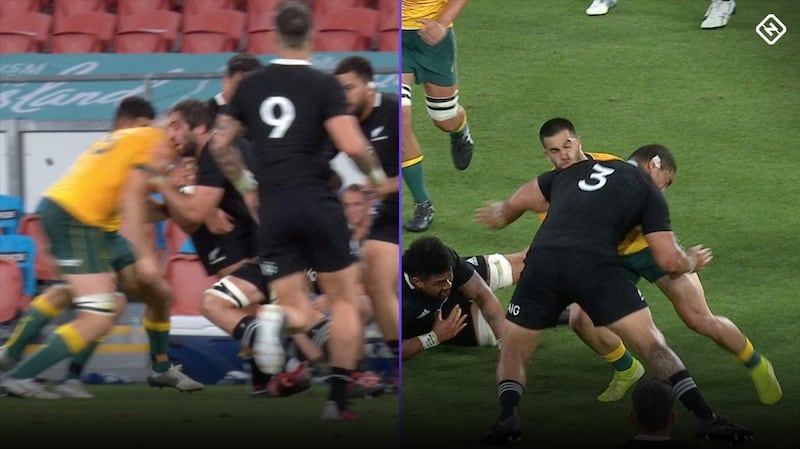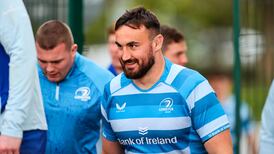Is rugby staring into the abyss?
Can it save itself?
Who will play it?
Nothing given for this hit on Josh van der Flier.
— Virgin Media Sport (@VMSportIE) December 19, 2020
Referee Pierre Brousset had a look at the screen but called it an "accidental collision".#LEIvNOR | #HeinekenChampionsCup pic.twitter.com/ii9gVDzRrY
These are the inevitable questions arising from the horrifying revelations of early dementia in top players who are barely into their 40s. An initial letter of claim for compensation has been delivered to World Rugby – they and all unions must now reflect hard on where they take the game from here.
These claims are not going to be easy to prove, and may not succeed. But, if they do end up in court, the damage to the image of rugby, which the spoken evidence will do, will be enormous, irreversible. Already, the accounts and interviews, with those whose suffering is unbearable, are very distressing.
What we have learned so far is very unlikely to be the whole of the iceberg and it is not going to drift away any time soon.
Changes are needed if rugby is to remain a sport which is played by countless schoolboys and amateurs. Serious thought must be given to these players who make up the vast majority (95 per cent) of the total playing population. Otherwise, we are heading towards a game, similar to the NFL, played by few, watched by millions.
RFU chief executive Bill Sweeney has stated that while worried about the reputational risk to rugby, the risk is “manageable”. Whatever that is supposed to mean, it is an extraordinary comment in the midst of what is happening.
Sweeney also says that “there is no reason to think that we are not insured”. Double negatives abounding, that’s about as clear as mud. But insurance policies can have strict clauses which are devastating to many a claim, so maybe he just doesn’t know.
I believe that these players must receive a settlement but the issue is not about insurance. It’s about stopping these head blows.
A very brave interview given by Alix Popham and his wife, Mel, really brings it all home. With a very young family, he undoubtedly wants his brain back but no amount of insurance money can help him.

As recently as last year Popham went for a cycle, taking a well known route; he had to use an app to find his way back. That was the start of it, along with mood changes and temper; the finish of it is unthinkable.
Sweeney also believes everything is being done to make the sport safe for kids. Well, I don’t know what he has been watching; because it is crystal clear that everything in the professional game flows into schools rugby. Inevitable, normal, it is also dangerous.
It flows too into amateur club rugby and is equally dangerous for the men and women who play there.
Clubs cannot be expected to have the same levels of back-up expertise, refereeing and medical assistance which exists in the pro game. World Rugby cannot ignore these issues.
What is needed is a change in the mode of play, starting at the very top. But, instead, we see more dangerous issues arising.
There is a clear, unhealthy, divergence of views between what is a red card and what is not. Let's first reference the two red cards given by Nic Berry in Australia v New Zealand – there is no doubt that some media, and very influential stakeholders, disagreed. These were forceful shoulders into the neck/head of the opponent; definite red cards.
We also see players charging into rucks cleaning out opponents with their shoulders and forearms. Some of these are being dismissed over-quickly as 'legal' clean-outs; TMO Pascal Gaüzère so decided, on a cursory glance, when Wales' Liam Williams arm-swiped an Italian to the head. No review, no card, nothing.
We saw very much the same when Toulouse’s David D’Ainu’u went off his feet, slamming into an Ulster player. No comment from the officials.

On Saturday, Josh van der Flier's face was on the receiving end of a flying shoulder from Northampton's Tom Wood. French referee Pierre Brousset declared it a legal clean-out; a shocking call. It was indisputably 'red'.
A conspiracy theorist would have a field day. There is no hope if these are being “legalised”.
Again, there is disagreement whereas total accord is needed.
It doesn’t bear thinking about seeing these actions in schools or the amateur game.
It’s a mighty paradox – reduce blows to the head, and allow these clean-outs. Impossible to reconcile.
If somebody can find a reference to ‘clean-outs’ in the law book, I’d be grateful. These high-velocity, torpedo-style human missiles must be banned, but aren’t they already illegal?
Let’s go technical for a moment:
The ruck law states – ‘joining a ruck’ – arriving players must be on their feet; they may join alongside but not in front of the hindmost player; they must bind onto a team-mate or opponent.
“Joining” indicates that a controlled entry is required.
And, by the way, the definition of ‘binding’ is: grasping another player firmly between the shoulders and the hips with the whole arm in contact from hand to shoulder. Furthermore, players must try and stay on their feet.
All of that is the complete polar opposite of what is happening. Rugby is flagrantly abusing its own laws, not to mention tinkering around with the very defined World Rugby protocols.
What directives are being given to referees and other match officials and can we see them, please?
World Rugby absolutely must sort out this confused and perilous shambles; and have the will to do so – those in charge must show strong unequivocal leadership, and deliver on their responsibilities. Immense responsibilities.
Otherwise, sadly, the answers to my opening questions are . . . ’yes, no, very few’.
- Owen Doyle is a former Test referee and former director of referees with the IRFU
















